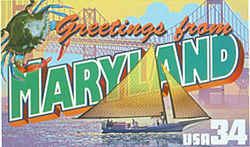Maryland Early History
First Early Inhabitants of Maryland

Early history examines the archaeological record that tells the story of the first inhabitants of Maryland. Learn about the prehistory and culture of the first early inhabitants, and what lessons it might teach us about the early history of Maryland.
Maryland First Early Inhabitants Timeline
- 35 Million - A meteorite impacted at what is now Chesapeake Bay and formed the largest impact crater in the US. (SFEC, 7/5/98, p.A10)
- 10,000 BC - First humans arrived by this date in the land that would become Maryland.
- 1,500 BC - Oysters became an important food resource.
- 1,000 BC - Native-American introduction of pottery.
- 800 AD. - Native-American introduction of domesticated plants; bow and arrow came into use.
- 1200 - Permanent Native-American villages established.
- 1498 - John Cabot sailed along Eastern Shore off present-day Worcester County.
- 1524 - Giovanni da Verrazano passed mouth of Chesapeake Bay.
- 1572 - Pedro Menendez de Aviles, Spanish governor of Florida, explored Chesapeake Bay.
- 1608 - Captain John Smith (1580-1631) explores the Chesapeake Bay - refer to Powhatan
- 1675 - 1675-l676 Bacon's Rebellion and the Declaration of the People. War with Susquehannocks in Maryland
- 1688 -
- 1688 - 1763 The French and Indian Wars between France and Great Britain for lands in North America consisting of King William's War (1688-1699), Queen Anne's War (1702-1713), King George's War (1744 - 1748) and the French and Indian War aka the Seven Years War (1754-1763)
- (1688-1699) King William's War (part of the French and Indian Wars) between France and the Wabanaki Confederacy and England and the Iroquois Confederacy. Peace Treaty made at Pemaquid. August 11,1693. and was ratified on Jan. 7. 1699
- 1754 - (1754-1763) French and Indian War known in the US as the Seven Years War, (part of the French and Indian Wars) between the colonies of France allied with the Wabanaki Confederacy, Algonquin tribes, Abenaki, Míkmaq, Mohawk, Lenape, Ojibwa, Ottawa, Shawnee, Wyandot and Great Britain allied with the Iroquois Confederacy, Onondaga, Oneida, Seneca, Tuscarora, Mohawk, Cayuga, Catawba and Cherokee tribes
Early History of Native Americans in Maryland
The Indigenous People of Maryland
The names of the Maryland tribes included the Lenape, Nanticoke, Piscataway, Conoy, Powhatan, Accohannock, Shawnee, Susquehannock, Tutelo and Saponi tribes.
Maryland was inhabited by Indians as early as circa 10,000 BC Permanent Indian villages were established by circa AD 1000.The Paleo-Indians who came more than 10,000 years ago from other parts of North America to hunt mammoth, great bison and caribou. By 1,000 BC, Maryland had more than 8,000 Native Americans in about 40 different tribes. Most of them spoke Algonquian languages.
These Native Americans lived in permanent communities where corn, beans, and squash were raised. They also hunted, fished, and harvested native plants to supplement their farming. Their homes, called longhouses, were usually located along the region's rivers and streams. They also hunted, fished and traded with tribes as far away as New York and Ohio.
We do not know what the Native Americans called the Chesapeake Bay. That name came from the Native American word "Chesepiuk," an Algonquian name for a village that the Roanoke, Virginia colonists discovered in 1585 near the mouth of the Bay. Later, mapmakers used the word to name the Bay. People have said that Chesapeake means "great salt water" or "great shellfish bay," but no records exist to verify those definitions.
Most of the tribal communities left the area as European settlers arrived in the 17th century. But these early inhabitants gave their names to many
of Maryland's rivers, towns, and counties.








